2012 FORD SUPER DUTY instrument cluster
[x] Cancel search: instrument clusterPage 44 of 93
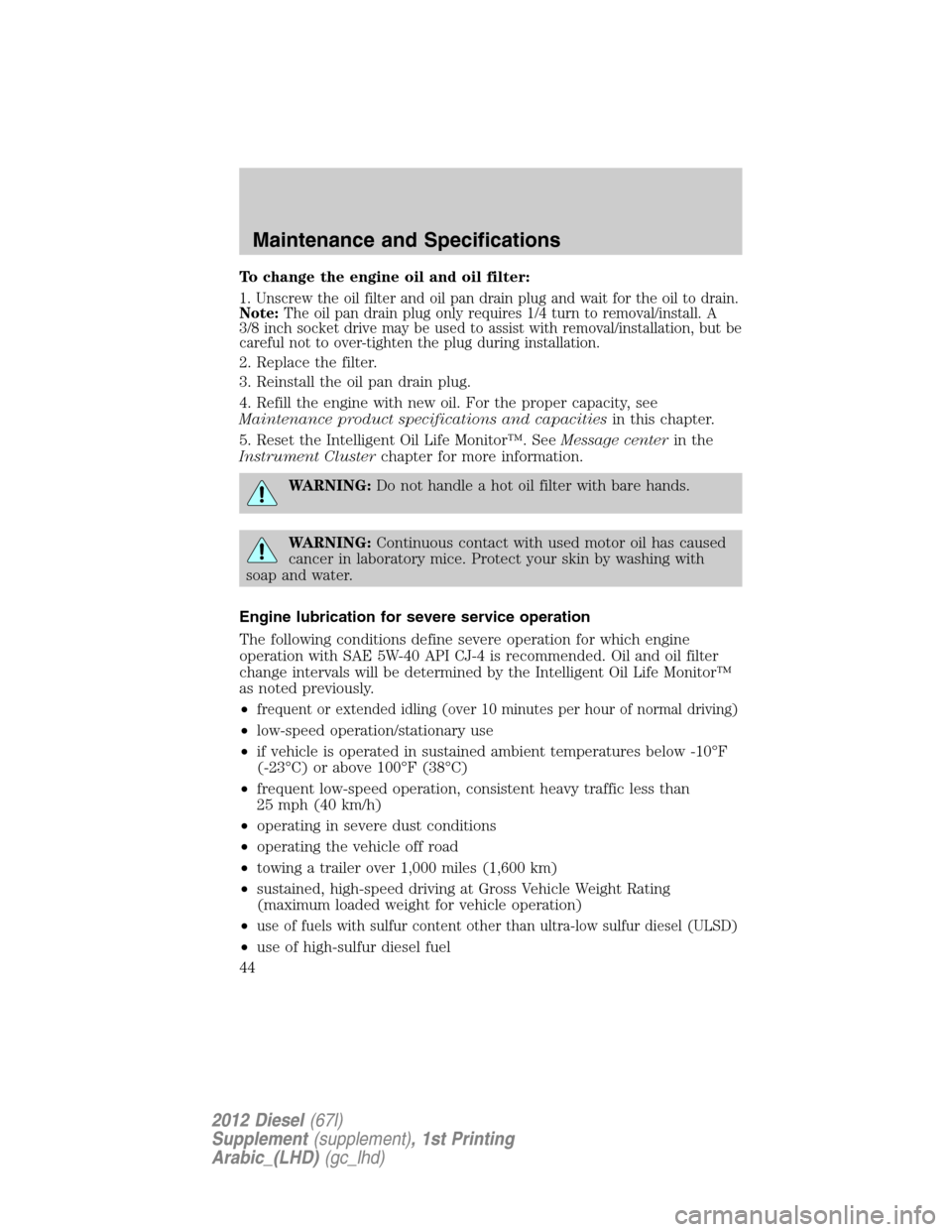
To change the engine oil and oil filter:
1. Unscrew the oil filter and oil pan drain plug and wait for the oil to drain.
Note:The oil pan drain plug only requires 1/4 turn to removal/install. A
3/8 inch socket drive may be used to assist with removal/installation, but be
careful not to over-tighten the plug during installation.
2. Replace the filter.
3. Reinstall the oil pan drain plug.
4. Refill the engine with new oil. For the proper capacity, see
Maintenance product specifications and capacitiesin this chapter.
5. Reset the Intelligent Oil Life Monitor™. SeeMessage centerin the
Instrument Clusterchapter for more information.
WARNING:Do not handle a hot oil filter with bare hands.
WARNING:Continuous contact with used motor oil has caused
cancer in laboratory mice. Protect your skin by washing with
soap and water.
Engine lubrication for severe service operation
The following conditions define severe operation for which engine
operation with SAE 5W-40 API CJ-4 is recommended. Oil and oil filter
change intervals will be determined by the Intelligent Oil Life Monitor™
as noted previously.
•
frequent or extended idling (over 10 minutes per hour of normal driving)
•low-speed operation/stationary use
•if vehicle is operated in sustained ambient temperatures below -10°F
(-23°C) or above 100°F (38°C)
•frequent low-speed operation, consistent heavy traffic less than
25 mph (40 km/h)
•operating in severe dust conditions
•operating the vehicle off road
•towing a trailer over 1,000 miles (1,600 km)
•sustained, high-speed driving at Gross Vehicle Weight Rating
(maximum loaded weight for vehicle operation)
•
use of fuels with sulfur content other than ultra-low sulfur diesel (ULSD)
•use of high-sulfur diesel fuel
Maintenance and Specifications
44
2012 Diesel(67l)
Supplement(supplement), 1st Printing
Arabic_(LHD)(gc_lhd)
Page 54 of 93
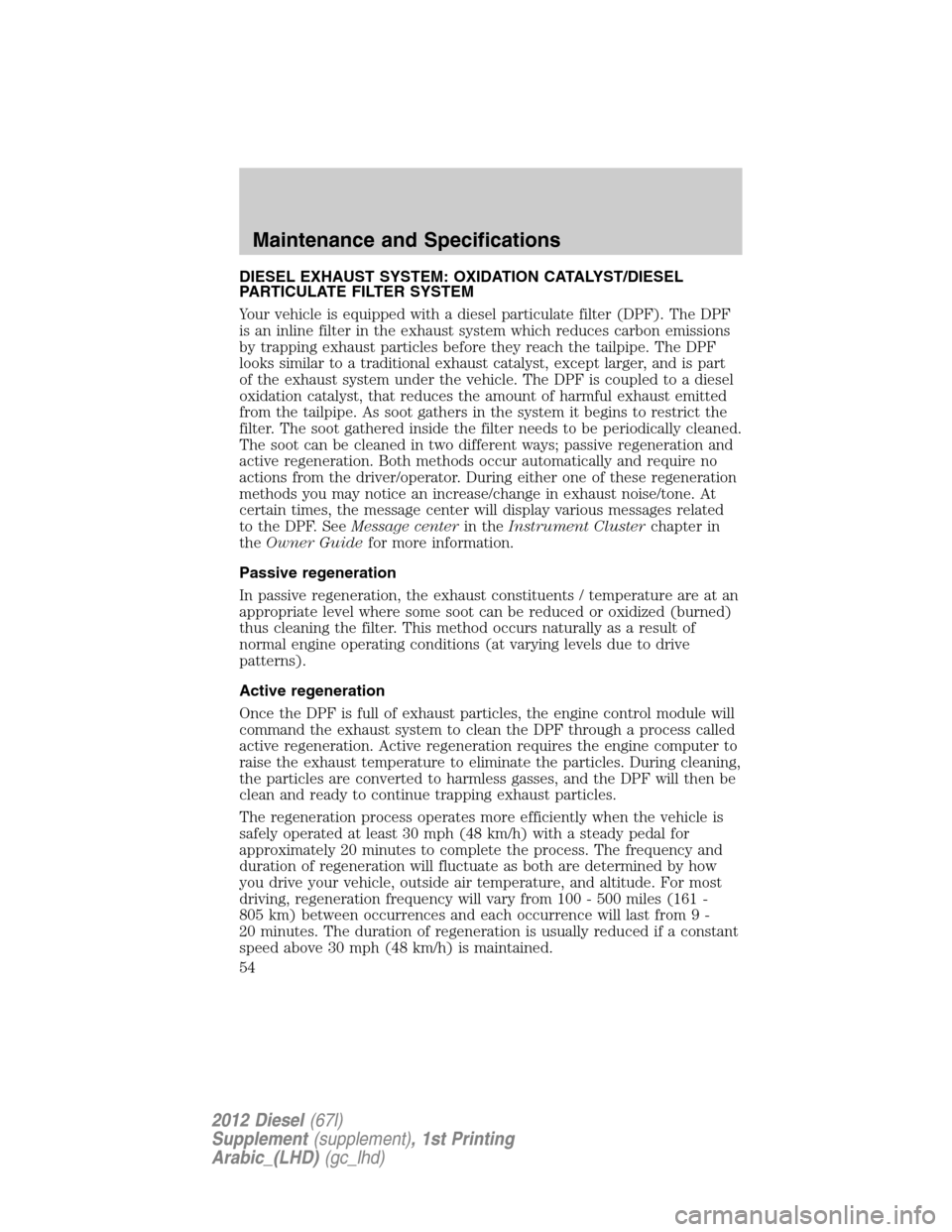
DIESEL EXHAUST SYSTEM: OXIDATION CATALYST/DIESEL
PARTICULATE FILTER SYSTEM
Your vehicle is equipped with a diesel particulate filter (DPF). The DPF
is an inline filter in the exhaust system which reduces carbon emissions
by trapping exhaust particles before they reach the tailpipe. The DPF
looks similar to a traditional exhaust catalyst, except larger, and is part
of the exhaust system under the vehicle. The DPF is coupled to a diesel
oxidation catalyst, that reduces the amount of harmful exhaust emitted
from the tailpipe. As soot gathers in the system it begins to restrict the
filter. The soot gathered inside the filter needs to be periodically cleaned.
The soot can be cleaned in two different ways; passive regeneration and
active regeneration. Both methods occur automatically and require no
actions from the driver/operator. During either one of these regeneration
methods you may notice an increase/change in exhaust noise/tone. At
certain times, the message center will display various messages related
to the DPF. SeeMessage centerin theInstrument Clusterchapter in
theOwner Guidefor more information.
Passive regeneration
In passive regeneration, the exhaust constituents / temperature are at an
appropriate level where some soot can be reduced or oxidized (burned)
thus cleaning the filter. This method occurs naturally as a result of
normal engine operating conditions (at varying levels due to drive
patterns).
Active regeneration
Once the DPF is full of exhaust particles, the engine control module will
command the exhaust system to clean the DPF through a process called
active regeneration. Active regeneration requires the engine computer to
raise the exhaust temperature to eliminate the particles. During cleaning,
the particles are converted to harmless gasses, and the DPF will then be
clean and ready to continue trapping exhaust particles.
The regeneration process operates more efficiently when the vehicle is
safely operated at least 30 mph (48 km/h) with a steady pedal for
approximately 20 minutes to complete the process. The frequency and
duration of regeneration will fluctuate as both are determined by how
you drive your vehicle, outside air temperature, and altitude. For most
driving, regeneration frequency will vary from 100 - 500 miles (161 -
805 km) between occurrences and each occurrence will last from 9 -
20 minutes. The duration of regeneration is usually reduced if a constant
speed above 30 mph (48 km/h) is maintained.
Maintenance and Specifications
54
2012 Diesel(67l)
Supplement(supplement), 1st Printing
Arabic_(LHD)(gc_lhd)
Page 55 of 93
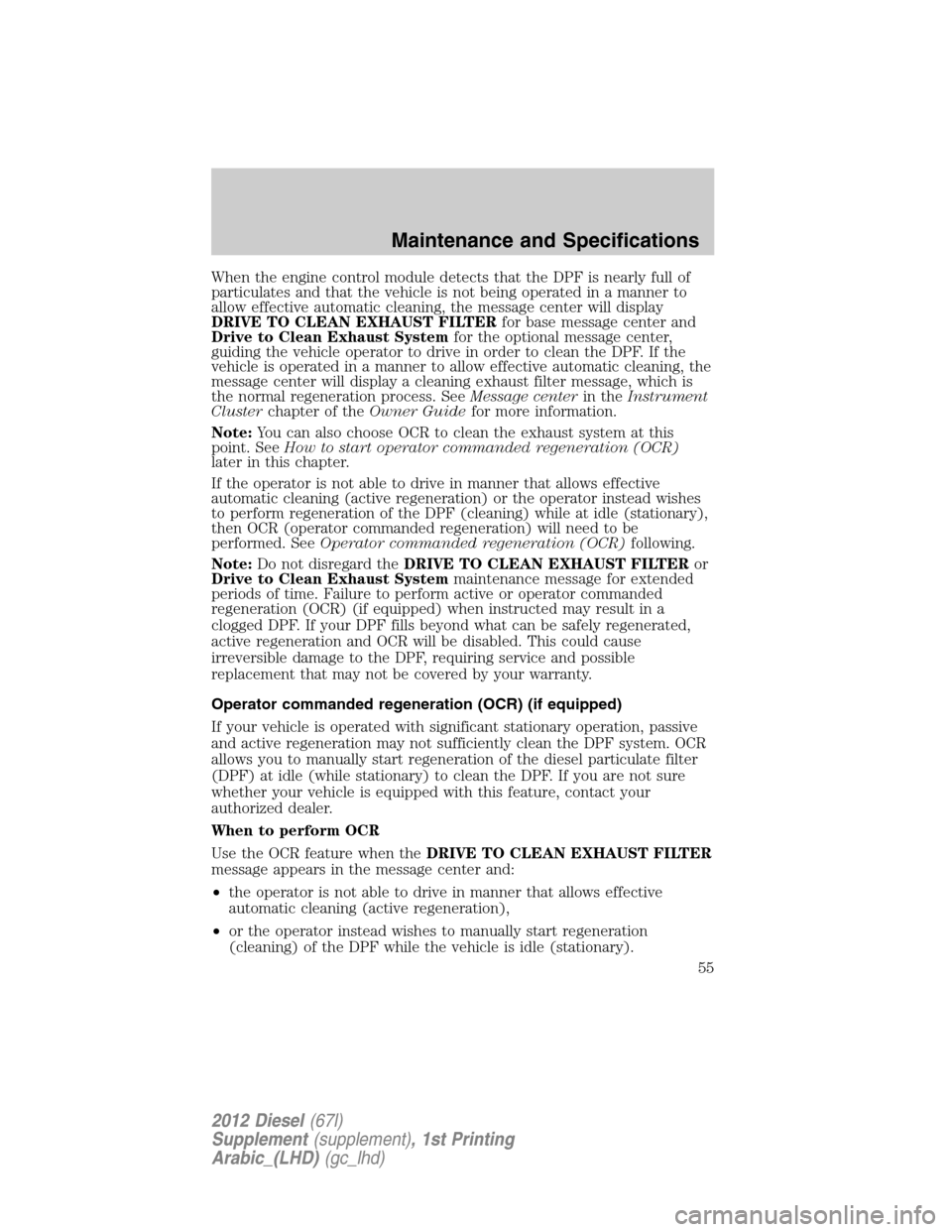
When the engine control module detects that the DPF is nearly full of
particulates and that the vehicle is not being operated in a manner to
allow effective automatic cleaning, the message center will display
DRIVE TO CLEAN EXHAUST FILTERfor base message center and
Drive to Clean Exhaust Systemfor the optional message center,
guiding the vehicle operator to drive in order to clean the DPF. If the
vehicle is operated in a manner to allow effective automatic cleaning, the
message center will display a cleaning exhaust filter message, which is
the normal regeneration process. SeeMessage centerin theInstrument
Clusterchapter of theOwner Guidefor more information.
Note:You can also choose OCR to clean the exhaust system at this
point. SeeHow to start operator commanded regeneration (OCR)
later in this chapter.
If the operator is not able to drive in manner that allows effective
automatic cleaning (active regeneration) or the operator instead wishes
to perform regeneration of the DPF (cleaning) while at idle (stationary),
then OCR (operator commanded regeneration) will need to be
performed. SeeOperator commanded regeneration (OCR)following.
Note:Do not disregard theDRIVE TO CLEAN EXHAUST FILTERor
Drive to Clean Exhaust Systemmaintenance message for extended
periods of time. Failure to perform active or operator commanded
regeneration (OCR) (if equipped) when instructed may result in a
clogged DPF. If your DPF fills beyond what can be safely regenerated,
active regeneration and OCR will be disabled. This could cause
irreversible damage to the DPF, requiring service and possible
replacement that may not be covered by your warranty.
Operator commanded regeneration (OCR) (if equipped)
If your vehicle is operated with significant stationary operation, passive
and active regeneration may not sufficiently clean the DPF system. OCR
allows you to manually start regeneration of the diesel particulate filter
(DPF) at idle (while stationary) to clean the DPF. If you are not sure
whether your vehicle is equipped with this feature, contact your
authorized dealer.
When to perform OCR
Use the OCR feature when theDRIVE TO CLEAN EXHAUST FILTER
message appears in the message center and:
•the operator is not able to drive in manner that allows effective
automatic cleaning (active regeneration),
•or the operator instead wishes to manually start regeneration
(cleaning) of the DPF while the vehicle is idle (stationary).
Maintenance and Specifications
55
2012 Diesel(67l)
Supplement(supplement), 1st Printing
Arabic_(LHD)(gc_lhd)
Page 68 of 93
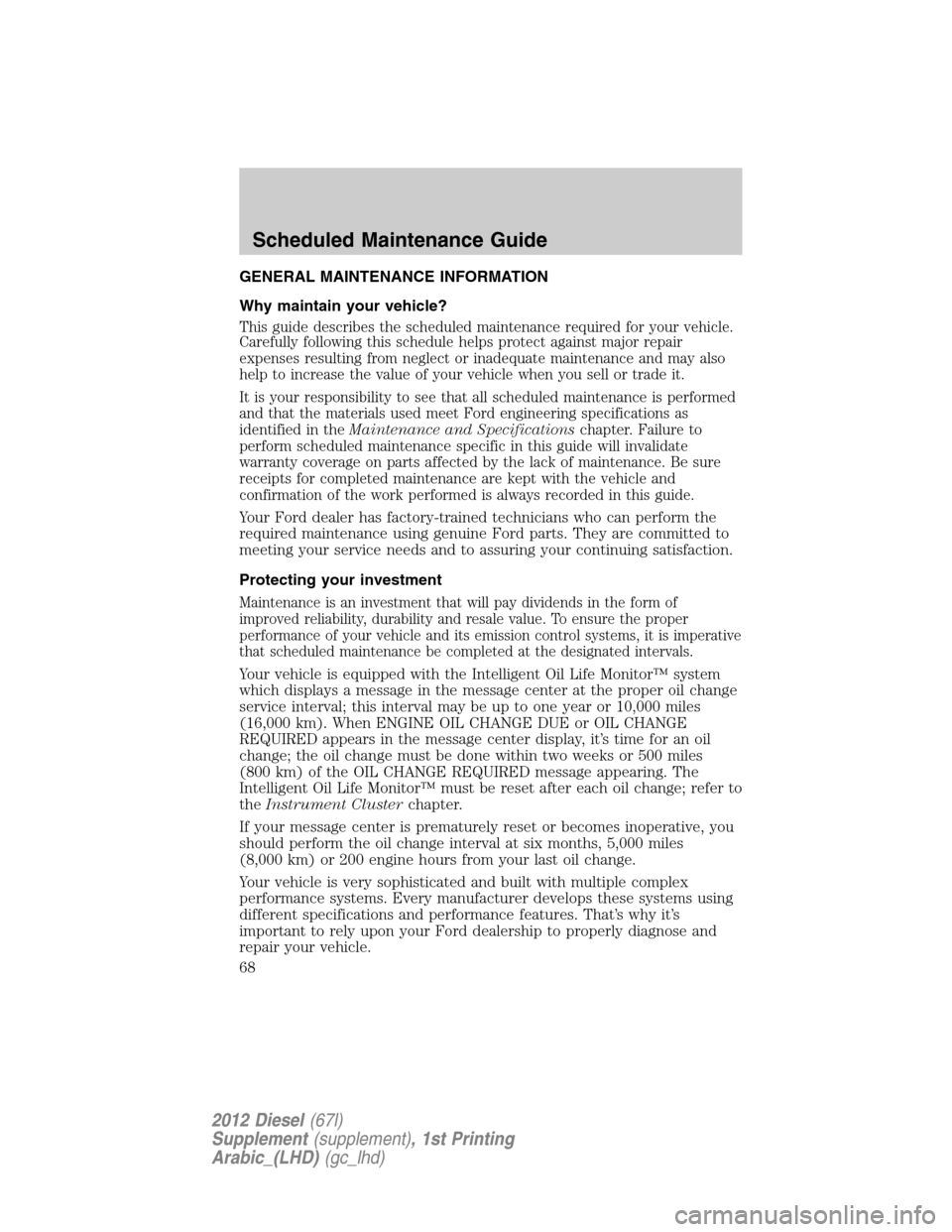
GENERAL MAINTENANCE INFORMATION
Why maintain your vehicle?
This guide describes the scheduled maintenance required for your vehicle.
Carefully following this schedule helps protect against major repair
expenses resulting from neglect or inadequate maintenance and may also
help to increase the value of your vehicle when you sell or trade it.
It is your responsibility to see that all scheduled maintenance is performed
and that the materials used meet Ford engineering specifications as
identified in theMaintenance and Specificationschapter. Failure to
perform scheduled maintenance specific in this guide will invalidate
warranty coverage on parts affected by the lack of maintenance. Be sure
receipts for completed maintenance are kept with the vehicle and
confirmation of the work performed is always recorded in this guide.
Your Ford dealer has factory-trained technicians who can perform the
required maintenance using genuine Ford parts. They are committed to
meeting your service needs and to assuring your continuing satisfaction.
Protecting your investment
Maintenance is an investment that will pay dividends in the form of
improved reliability, durability and resale value. To ensure the proper
performance of your vehicle and its emission control systems, it is imperative
that scheduled maintenance be completed at the designated intervals.
Your vehicle is equipped with the Intelligent Oil Life Monitor™ system
which displays a message in the message center at the proper oil change
service interval; this interval may be up to one year or 10,000 miles
(16,000 km). When ENGINE OIL CHANGE DUE or OIL CHANGE
REQUIRED appears in the message center display, it’s time for an oil
change; the oil change must be done within two weeks or 500 miles
(800 km) of the OIL CHANGE REQUIRED message appearing. The
Intelligent Oil Life Monitor™ must be reset after each oil change; refer to
theInstrument Clusterchapter.
If your message center is prematurely reset or becomes inoperative, you
should perform the oil change interval at six months, 5,000 miles
(8,000 km) or 200 engine hours from your last oil change.
Your vehicle is very sophisticated and built with multiple complex
performance systems. Every manufacturer develops these systems using
different specifications and performance features. That’s why it’s
important to rely upon your Ford dealership to properly diagnose and
repair your vehicle.
Scheduled Maintenance Guide
68
2012 Diesel(67l)
Supplement(supplement), 1st Printing
Arabic_(LHD)(gc_lhd)
Page 74 of 93
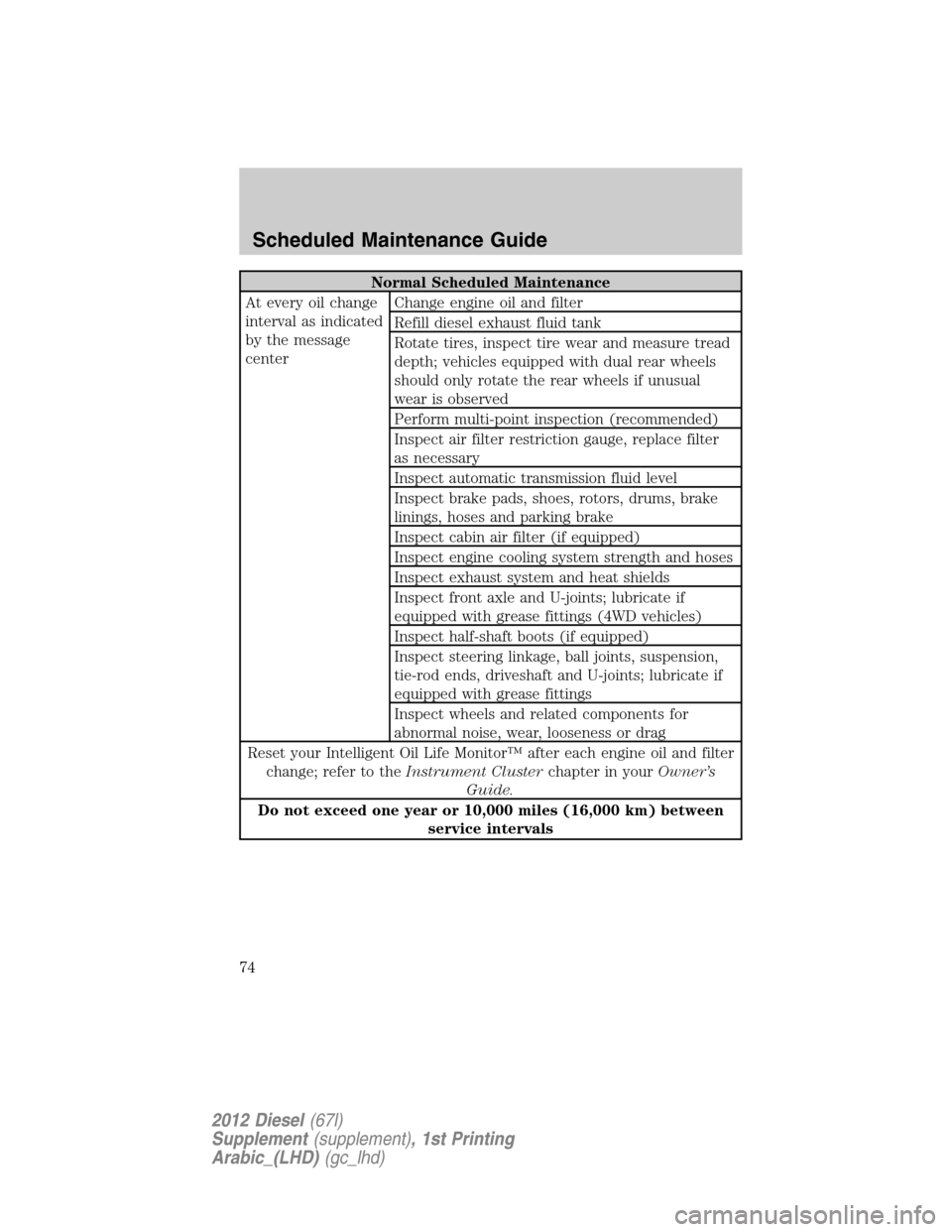
Normal Scheduled Maintenance
At every oil change
interval as indicated
by the message
centerChange engine oil and filter
Refill diesel exhaust fluid tank
Rotate tires, inspect tire wear and measure tread
depth; vehicles equipped with dual rear wheels
should only rotate the rear wheels if unusual
wear is observed
Perform multi-point inspection (recommended)
Inspect air filter restriction gauge, replace filter
as necessary
Inspect automatic transmission fluid level
Inspect brake pads, shoes, rotors, drums, brake
linings, hoses and parking brake
Inspect cabin air filter (if equipped)
Inspect engine cooling system strength and hoses
Inspect exhaust system and heat shields
Inspect front axle and U-joints; lubricate if
equipped with grease fittings (4WD vehicles)
Inspect half-shaft boots (if equipped)
Inspect steering linkage, ball joints, suspension,
tie-rod ends, driveshaft and U-joints; lubricate if
equipped with grease fittings
Inspect wheels and related components for
abnormal noise, wear, looseness or drag
Reset your Intelligent Oil Life Monitor™ after each engine oil and filter
change; refer to theInstrument Clusterchapter in yourOwner’s
Guide.
Do not exceed one year or 10,000 miles (16,000 km) between
service intervals
Scheduled Maintenance Guide
74
2012 Diesel(67l)
Supplement(supplement), 1st Printing
Arabic_(LHD)(gc_lhd)
Page 85 of 93
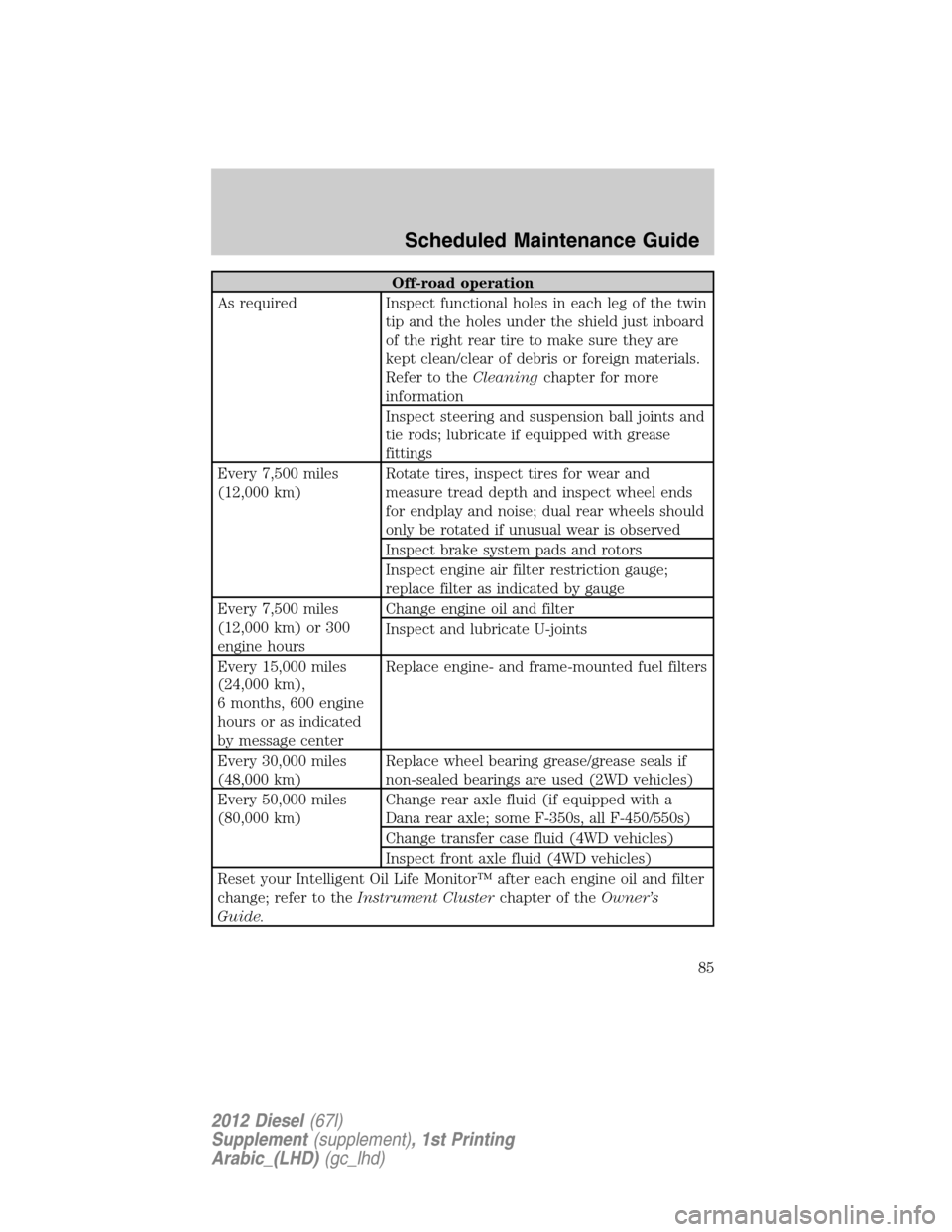
Off-road operation
As required Inspect functional holes in each leg of the twin
tip and the holes under the shield just inboard
of the right rear tire to make sure they are
kept clean/clear of debris or foreign materials.
Refer to theCleaningchapter for more
information
Inspect steering and suspension ball joints and
tie rods; lubricate if equipped with grease
fittings
Every 7,500 miles
(12,000 km)Rotate tires, inspect tires for wear and
measure tread depth and inspect wheel ends
for endplay and noise; dual rear wheels should
only be rotated if unusual wear is observed
Inspect brake system pads and rotors
Inspect engine air filter restriction gauge;
replace filter as indicated by gauge
Every 7,500 miles
(12,000 km) or 300
engine hoursChange engine oil and filter
Inspect and lubricate U-joints
Every 15,000 miles
(24,000 km),
6 months, 600 engine
hours or as indicated
by message centerReplace engine- and frame-mounted fuel filters
Every 30,000 miles
(48,000 km)Replace wheel bearing grease/grease seals if
non-sealed bearings are used (2WD vehicles)
Every 50,000 miles
(80,000 km)Change rear axle fluid (if equipped with a
Dana rear axle; some F-350s, all F-450/550s)
Change transfer case fluid (4WD vehicles)
Inspect front axle fluid (4WD vehicles)
Reset your Intelligent Oil Life Monitor™ after each engine oil and filter
change; refer to theInstrument Clusterchapter of theOwner’s
Guide.
Scheduled Maintenance Guide
85
2012 Diesel(67l)
Supplement(supplement), 1st Printing
Arabic_(LHD)(gc_lhd)
Page 86 of 93
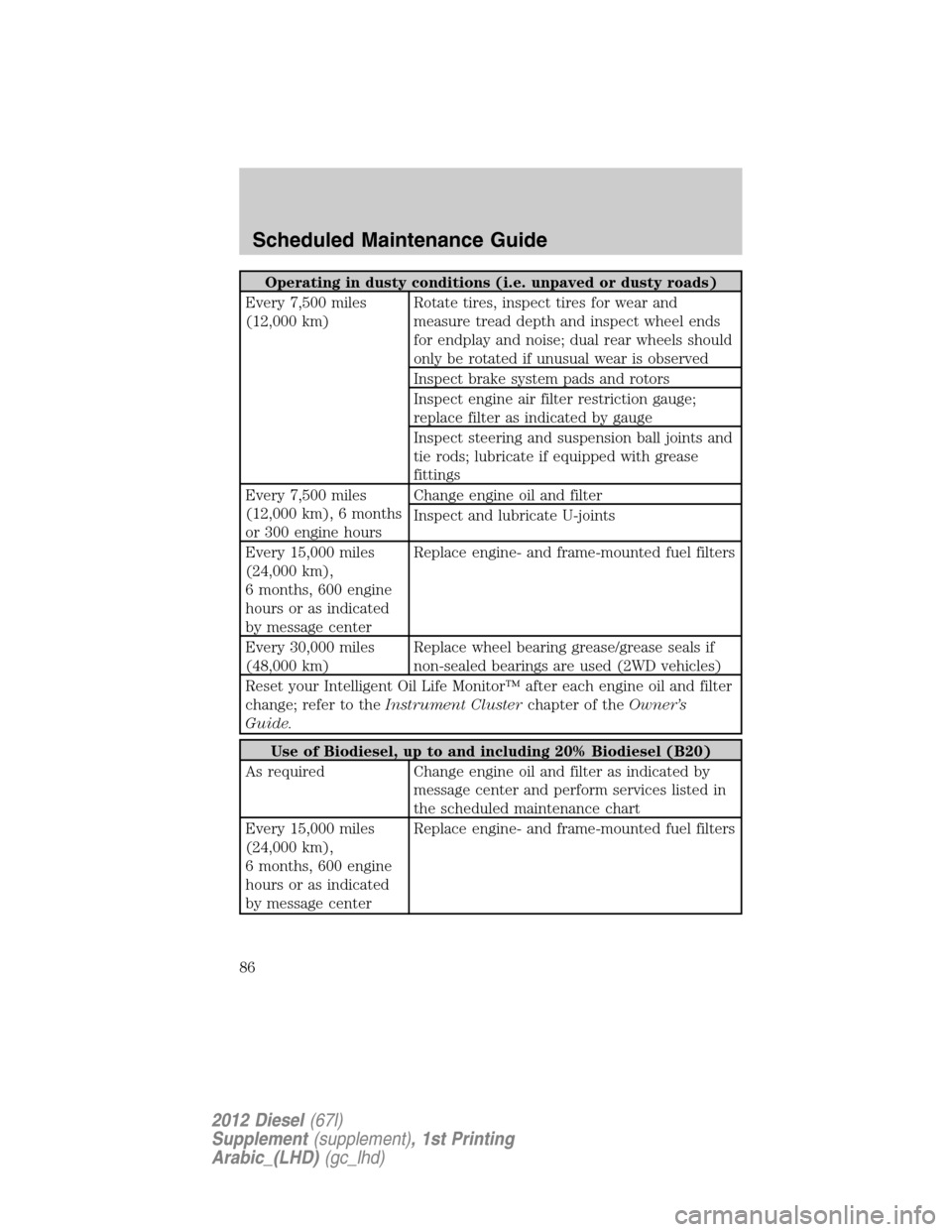
Operating in dusty conditions (i.e. unpaved or dusty roads)
Every 7,500 miles
(12,000 km)Rotate tires, inspect tires for wear and
measure tread depth and inspect wheel ends
for endplay and noise; dual rear wheels should
only be rotated if unusual wear is observed
Inspect brake system pads and rotors
Inspect engine air filter restriction gauge;
replace filter as indicated by gauge
Inspect steering and suspension ball joints and
tie rods; lubricate if equipped with grease
fittings
Every 7,500 miles
(12,000 km), 6 months
or 300 engine hoursChange engine oil and filter
Inspect and lubricate U-joints
Every 15,000 miles
(24,000 km),
6 months, 600 engine
hours or as indicated
by message centerReplace engine- and frame-mounted fuel filters
Every 30,000 miles
(48,000 km)Replace wheel bearing grease/grease seals if
non-sealed bearings are used (2WD vehicles)
Reset your Intelligent Oil Life Monitor™ after each engine oil and filter
change; refer to theInstrument Clusterchapter of theOwner’s
Guide.
Use of Biodiesel, up to and including 20% Biodiesel (B20)
As required Change engine oil and filter as indicated by
message center and perform services listed in
the scheduled maintenance chart
Every 15,000 miles
(24,000 km),
6 months, 600 engine
hours or as indicated
by message centerReplace engine- and frame-mounted fuel filters
Scheduled Maintenance Guide
86
2012 Diesel(67l)
Supplement(supplement), 1st Printing
Arabic_(LHD)(gc_lhd)
Page 87 of 93
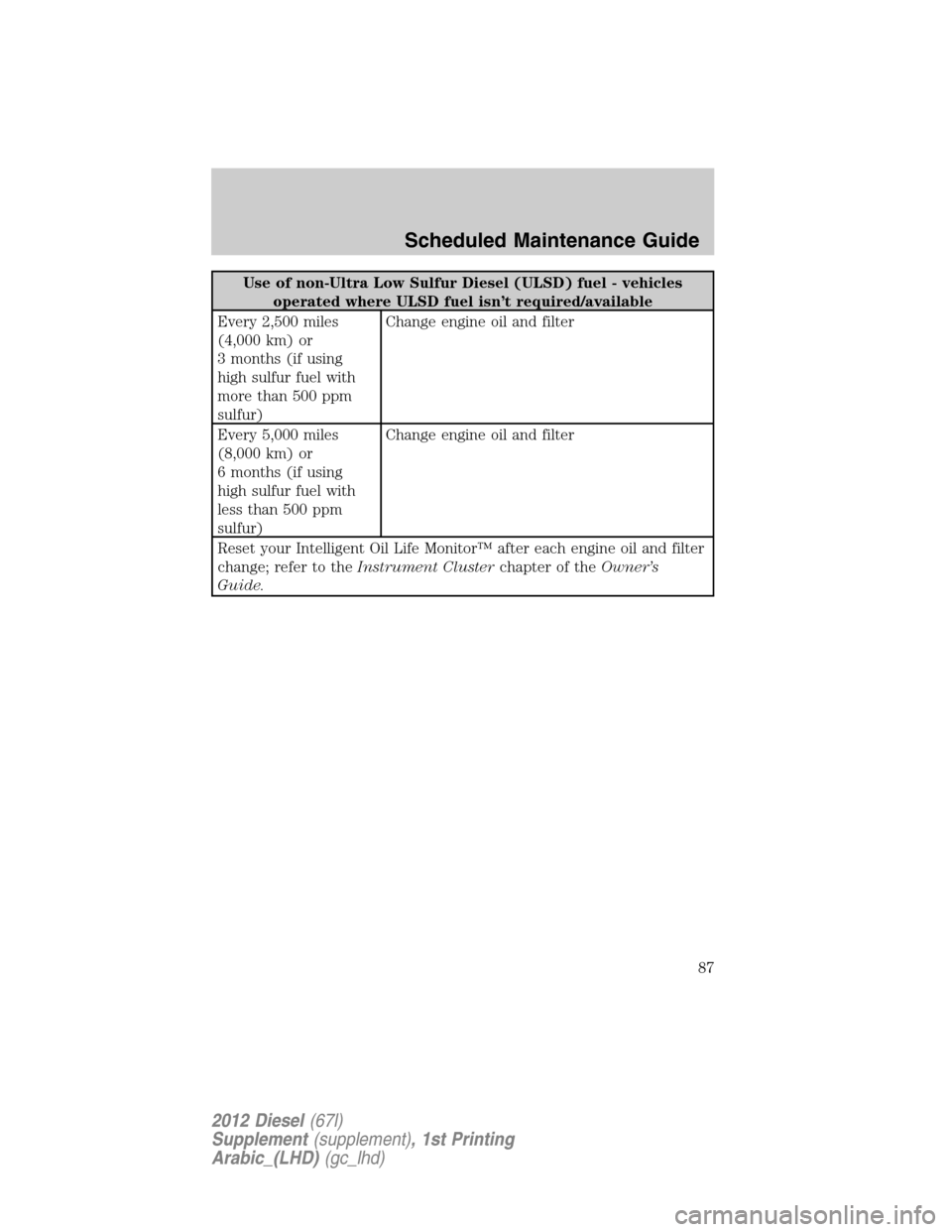
Use of non-Ultra Low Sulfur Diesel (ULSD) fuel - vehicles
operated where ULSD fuel isn’t required/available
Every 2,500 miles
(4,000 km) or
3 months (if using
high sulfur fuel with
more than 500 ppm
sulfur)Change engine oil and filter
Every 5,000 miles
(8,000 km) or
6 months (if using
high sulfur fuel with
less than 500 ppm
sulfur)Change engine oil and filter
Reset your Intelligent Oil Life Monitor™ after each engine oil and filter
change; refer to theInstrument Clusterchapter of theOwner’s
Guide.
Scheduled Maintenance Guide
87
2012 Diesel(67l)
Supplement(supplement), 1st Printing
Arabic_(LHD)(gc_lhd)